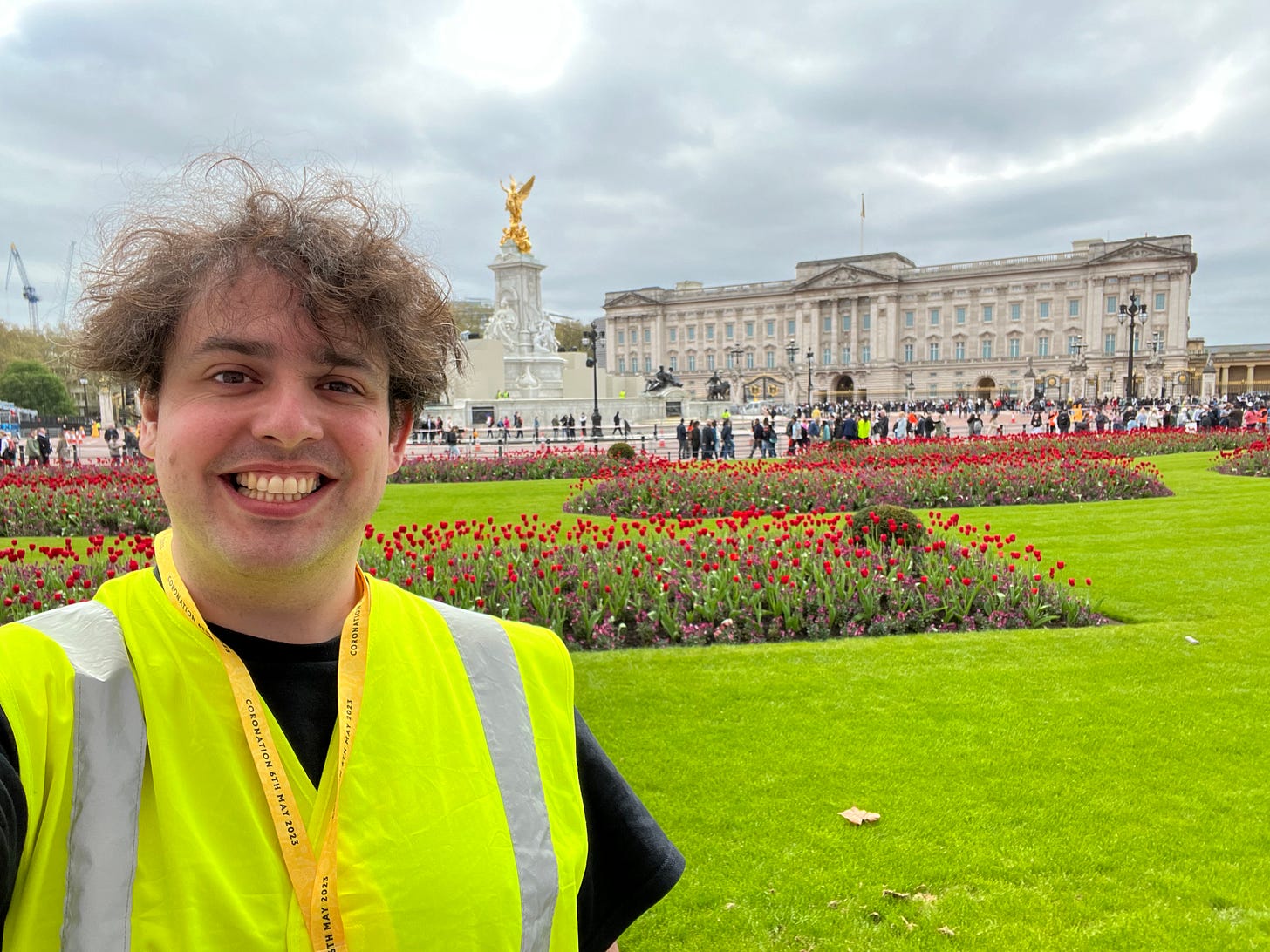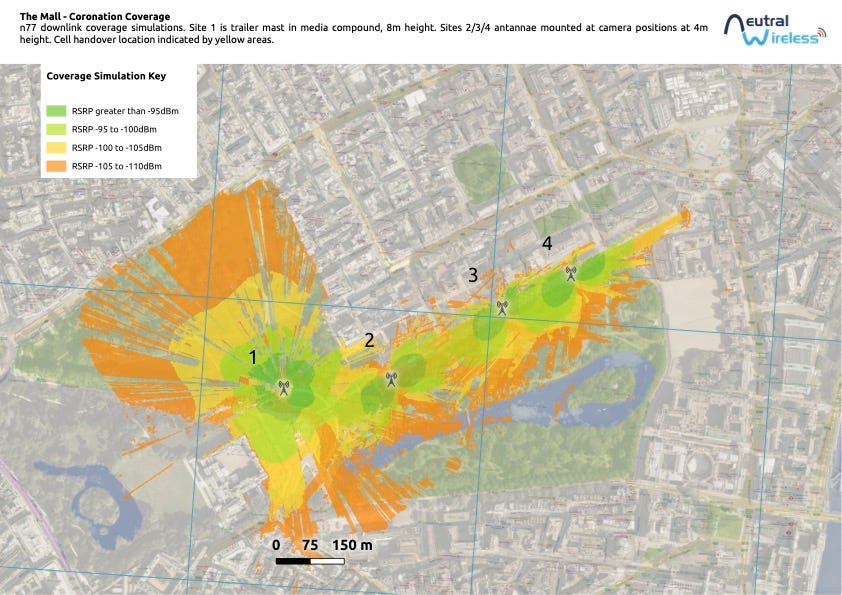Using a Private 5G Network to Broadcast The Coronation
With CBS News, BBC R&D, Neutral Wireless, LiveU and King Charles III
As of 2024, I'm no longer posting on Substack. Find my blog posts on my Patreon instead, or for links to all my social media go to mattg.co.uk
For the last week I’ve been working outside Buckingham Palace as part of CBS News’ team broadcasting coverage of King Charles III’s coronation. My role was to ensure that CBS correspondents Imtiaz Tyab and Chris Livesay could share the mood of the crowd along The mall and views of the procession up to Buckingham Palace. I did this working with BBC Research and Development and Neutral Wireless who set up a private 5G network for the event, using LiveU’s LU800 field units.
Background: You can broadcast on 5G‽
Thanks to the improvements in mobile broadband technology the last few years, live TV crews no longer need to be attached by cables to a satellite truck, and can now broadcast from pretty much anywhere populated. Devices such as LiveU products take the audiovisual signal from a camera, and transmit it back to base over the public internet.
Because signal quality can vary depending on your location and mobile network, It’s common practice to use multiple mobile networks all at once, and if available use wired internet too. The LiveU units spread the data across all the available internet connections to get the best combination of speed and reliability.
Day-to-day, this is all good and well but large events bring their own complications. You may have noticed when at a stadium or other large event, your phone says it has full signal but won’t give you any internet or even make calls. Every mobile cell tower has a maximum capacity of a few thousand people. When you’re in a massive crowd your phone may show full signal knowing that there’s a cell tower nearby, but the sheer amount of devices trying to use it can overwhelm both its wireless capacity and its connectivity to the internet.
At an event such as the coronation, the expected hundred thousand people in attendence meant that the mobile networks would be under a huge amount of strain, and therefore not reliable for broadacast.
Testing a Broadcast-Only 5G Network
BBC R&D teamed up with Neutral Wireless to build a private 5G network at outside Buckingham Palace and down The Mall, and offered it to broadcasters to use for the event. I’d recommend reading the BBC R&D blog post about this side of it if you’re interested.
I was asked by Simon Jackson-Lyall in CBS News’ London Engineering Team to help test, plan and support their use of this network for the Coronation.
On a rainy day in March, people from multiple broadcasters brought their kit down to Canada Gate, by Buckingham Palace, to do the first test of the 5G network. The plan was for us all to get everything connected and transmitting video at the same time to make sure it could cope with the traffic and be useable for broadcast.
The next concern was signal range. Neutral Wireless were licenced to use a frequency around 3.8GHz at the top of the 5G range, way above what’s used for 2-4G currently. The higher the frequency, the more likely the signal will be blocked by obstructions like people and trees.
I went for a wander with a LiveU LU800 and a camera streaming back to base, and kept an eye on the bitrate I was streaming at. Unsurprisingly, I noticed that when I was a bit further from the antenna and turned so my body was between it and the LiveU backpack, the bitrate would drop dramatically, and even more so when there were trees in between too. A call to MCR confirmed that this affected the picture too, so we needed a solution to keep our 5G antennas out of the crowd.

A Solution: The Gandalf Stick
Elevating the 5G antennas was a mechanical problem. We first looked at ways of fixing them to the liveU backpack so they were above head height, but were worried about them moving and accidentally whacking either the LiveU operator or members of the public.
We settled on mounting LiveU’s external 5G modems to the top of a microphone boom pole. That way they could go up to 3m high, but also collapse much shorter. To attach the 5G modems, I made a bracket out of aluminum angle, with holes for cable ties and velcro to stop the modems from slipping out.


Coronation Week
I arrived on site at the Buckingham Palace media compound on Tuesday, 4 days before the coronation. NW and BBC R&D had already built the 4 cell sites and shared a map of predicted signal strength from their simulations, so it was time to do a lot of walking to see if expectation matched reality.
Initially, the performance I was getting wasn’t quite what was predicted, and it was only really useable right in front of the cells, with my mast at its fullest extent. At this point, they were still tweaking and optimising the network while also trying to operate within some updated boundaries from Ofcom, the UK’s communications regulator.
At no point did I expect the network to “magically work” everywhere, so I had planned to make a map of the area for CBS News’ roving crews to use so they knew their chances of getting on air. It’s one thing providing technology for broadcast, but without considering the mindset and workflow of the production teams who will be using it, there’s no way they can get the most out of it. I figured they’d be focussed on finding good shots from in the crowd, and would need a quick and easy way to check if they could broadcast from there.
I shared the map and my findings with the 5G team and they were able to use this to greatly improve both the coverage, and the handoff between cells when moving along The Mall. It went from being useful in a few zones, to covering the majority of both The Mall and the busy areas of St James’ Park: exceeding what I’d expected from the simulation. (I even managed to get a 4Mbps video stream at the corner of Horse Guards Parade, albeit with the antennas pointing a very specific direction and while standing on tiptoes!)




The Broadcast
On the day of the coronation, CBS News had two crews using the 5G setup. One with correspondent Imtiaz Tyab on the north of the mall, and the other with Chris Livesay in St James’ Park.
I was based in the CBS Truck monitoring the LiveU units remotely on my laptop, with a feed of the program being sent out to the CBS Network. The LiveU Central web interface allows you to remotely control all the information about the unit, its connectivity, and the bitrate it’s currently achieving. You can also stream low latency, low quality video from the units too.
We limited each to 5Mbps, both to save from interference and to not use more than our fair share of the 5G. Having seen some interference and one of the modems bouncing a little during rehearsal, I dropped the bitrate of the northern LiveU to 4Mbps. LiveUs change their bitrate (and other parameters) for the available bandwidth, but as the interference was causing quite dramatic changes between low and high, we were seeing artefacts in the picture when it adapted the settings.
I was very happy to see it all held up, allowing not only both correspondents to be used regularly on air, but also as extra viewpoints of the procession.
The Team
This of course is just my point of view from what was a massive team effort.
Thanks to Simon Jackson-Lyall, Ed Tickner, Jimmy Parkin, Mike Redgrave and the rest of the team at CBS News’ London Bureau, Ian Wagdin and the BBC R&D team, Samuel Yoffe and Douglas Allan and the Neutral Wireless team, Dave Fowler from LiveU and Simon Ashton from BBC News Engineering.
Me
If you’re new to me, hi, I’m Matt, a freelance broadcast engineer and YouTuber based in London.
I’m @MattGrayYes on pretty much everything and you can find out more about me and links to my social media at mattg.co.uk.










